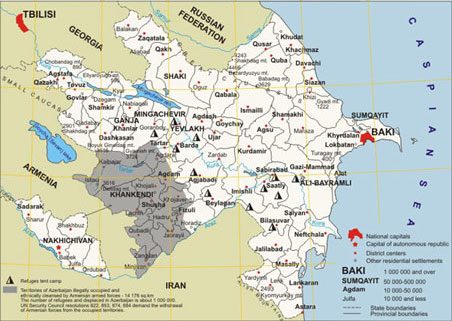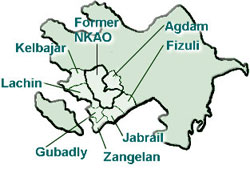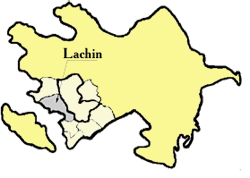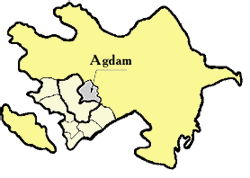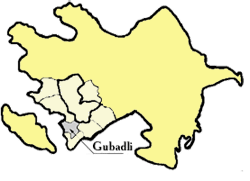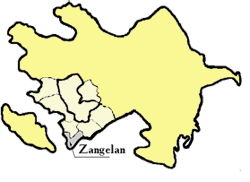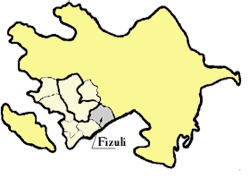Media Coverage of The Azeri Massacres by Armenians
The Ethnic Cleansing of Azeris in Armenia, Nagorno-Karabakh and the Occupied Azerbaijan Territories
Newsweek, November 29, 1993
Armenians occupy a quarter of Azerbaijan’s territory, and they’ve displaced almost a million Azerbaijani civilians. Friends of Armenia’s powerful lobby in Washington, including the U.S. Government are suddenly a bit aghast. ‘What we see now is a systematic destruction of every village in their way’ says a senior state department official. It’s vandalism…
The Guardian, 2 September 1993
NOWHERE TO HIDE FOR AZERI REFUGEES: Armenia is pushing a new wave of displaced people towards Iran. Jonathan RUGMAN in Kanliq, south-west Azerbaijan, reports – On the main road south through Kubatli province, thousands of men, women and children are packed into trucks at an Azeri checkpoint waiting for permission to leave. Helicopters shuttle in and out with the wounded, while a group of women sit wailing at the roadside, tearing at their bloodstained faces with their fingernails in a frenzy of grief.
A new exodus of refugees is under way towards Azerbaijan’s border with Iran as Armenia forces continue ignoring United Nations demands that they stop their offensive.
This week the UNHCR began distributing 4,000 tents and 50,000 blankets to those displaced in the recent hostilities. The organisation said about 250,000 Azeris have been displaced so far this year and about 1 million since the massacre began in 1988.
Newsweek, 16 March 1992
THE FACE OF A MASSACRE : By Pascal Privat with Steve Le Vine in MoscowAzerbaijan was a charnel house again last week: a place of mourning refugees and dozens of mangled corpses dragged to a makeshift morgue behind the mosque. They were ordinary Azerbaijani men, women and children of Khojaly, a small village in war-torn Nagorno-Karabakh overrun by Armenian forces on Feb. 25-26. Many were killed at close range while trying to flee; some had their faces mutilated, others were scalped. While the victims’ families mourned.
The New York Times, March 3, 1992
MASSACRE BY ARMENIANS: Agdam, Azerbaijan, March 2 (Reuters) – Fresh evidence emerged today of a massacre of civilians by Armenian militants in Nagorno-Karabakh, a predominantly Armenian enclave of Azerbaijan.
Scalping Reported – Azerbaijani officials and journalists who flew briefly to the region by helicopter brought back three dead children with the back of their heads blown off. They said shooting by Armenians has prevented them from retrieving more bodies.
“Women and children have been scalped,” said Assad Faradshev, an aide to Nagorno-Karabakh’s Azerbaijani Governor. “When we began to pick up bodies, they began firing at us.”
The Azerbaijani militia chief in Agdam, Rashid Mamedov, said: “The bodies are lying there like flocks of sheep. Even the fascists did nothing like this.”
Truckloads of Bodies -Near Agdam on the outskirts of Nagorno-Karabakh, a Reuters photographer, Frederique Lengaigne, said she had seen two trucks filled with Azerbaijani bodies.
“In the first one I counted 35, and it looked as though there were as many in the second,” she said. “Some had their head cut off, and many had been burned. They were all men, and a few had been wearing khaki uniforms.”
The Sunday Times, 1 March 1992
ARMENIAN SOLDIERS MASSACRE HUNDREDS OF FLEEING FAMILIES: By Thomas Goltz, Agdam, Azerbaijan – Survivors reported that Armenian soldiers shot and bayoneted more than 450 Azeris, many of them women and children. Hundreds, possibly thousands, were missing and feared dead.
The attackers killed most of the soldiers and volunteers defending the women and children. They then turned their guns on the terrified refugees. The few survivors later described what happened: ‘That’s when the real slaughter began,’ said Azer Hajiev, one of three soldiers to survive. ‘The Armenians just shot and shot. And then they came in and started carving up people with their bayonets and knives.’
‘They were shooting, shooting, shooting,’ echoed Rasia Aslanova, who arrived in Agdam with other women and children who made their way through Armenian lines. She said her husband, Kayun, and a son-in-law were massacred in front of her. Her daughter was still missing.
One boy who arrived in Agdam had an ear sliced off.
The survivors said 2000 others, some of whom had fled separately, were still missing in the gruelling terrain; many could perish from their wounds or the cold.
By late yesterday, 479 deaths had been registered at the morgue in Agdam’s morgue, and 29 bodies had been buried in the cemetery. Of the seven corpses I saw awaiting burial, two were children and three were women, one shot through the chest at point blank range.
Agdam hospital was a scene of carnage and terror. Doctors said they had 140 patients who escaped slaughter, most with bullet injuries or deep stab wounds.
Nor were they safe in Agdam. On friday night rockets fell on the city which has a population of 150,000, destroying several buildings and killing one person.
The Times, 2 March 1992
CORPSES LITTER HILLS IN KARABAKH
(ANATOL LIEVEN COMES UNDER FIRE WHILE FLYING TO INVESTIGATE THE MASS KILLINGS OF REFUGEES BY ARMENIAN TROOPS): As we swooped low over the snow-covered hills of Nagorno-Karabagh we saw the scattered corpses. Apparently, the refugees had been shot down as they ran. An Azerbaijani film of the places we flew over, shown to journalists afterwards, showed DOZENS OF CORPSES lying in various parts of the hills.
The Azerbaijanis claim that AS MANY AS 1000 have died in a MASS KILLING of AZERBAIJANIS fleeing from the town of Khodjaly, seized by Armenians last week. A further 4,000 are believed to be wounded, frozen to death or missing.
The civilian helicopter’s job was to land in the mountains and pick up bodies at sites of the mass killings.
The civilian helicopter picked up four corpses, and it was during this and a previous mission that an Azerbaijani cameraman filmed the several dozen bodies on the hillsides.
Back at the airfield in Agdam, we took a look at the bodies the civilian helicopter had picked up. Two old men a small girl were covered with blood, their limbs contorted by the cold and rigor mortis. They had been shot.
TIME, 16 March 1992
M A S S A C R E I N K H O J A L Y: By Jill SMOLOWE -Reported by Yuri ZARAKHOVICH/Moscow – While the details are argued, this much is plain: something grim and unconscionable happened in the Azerbaijani town of Khojaly two weeks ago. So far, some 200 dead Azerbaijanis, many of them mutilated, have been transported out of the town tucked inside the Armenian-dominated enclave of Nagorno-Karabakh for burial in neighboring Azerbaijan. The total number of deaths – the Azerbaijanis claim 1,324 civilians have been slaughtered, most of them women and children – is unknown.
Videotapes circulated by the Azerbaijanis include images of defaced civilians, some of them scalped, others shot in the head.
BBC1 Morning News, 3 March 1992
BBC reporter was live on line and he claimed that he saw more than 100 bodies of Azeri men, women and children as well as a baby who are shot dead from their heads from a very short distance.
BBC1 Morning News, 3 March 1992
Very disturbing picture has shown that many civilian corpses who were picked up from mountain. Reporter said he, cameraman and Western Journalists have seen more than 100 corpses, who are men, women, children, massacred by Armenians.
They have
been shot dead from their heads as close as 1 meter. Picture also has shown nearly ten bodies (mainly women and children) are shot dead from their heads. Azerbaijan claimed that more than 1000 civilians massacred by Armenian forces.
Channel 4 News, 2 March 1992
2 French journalists have seen 32 corpses of men, women and children in civilian clothes. Many of them shot dead from their heads as close as less than 1 meter.
Report from Karabakpress – A merciless massacre of the civilian population of the small Azeri town of Khojali (Population 6000) in Karabagh, Azerbaijan, is reported to have taken place on the night of February 28 bythe Soviet Armenian Army. Close to 1000 people are reported to have been massacred. Elderly and children were not spared. Many were badly beaten and shot at close range. A sense of rage and helplessness has overwhelmed the Azeri population in face of the well armed and equipped Armenian Army. The neighboring Azeri city of Aghdam outside of the Karabagh region has come under heavy Armenian artillery shelling. City hospital was hit and two pregnant women as well as a new born infant were killed. Azerbaijan is appealing to the international community to condemn such barbaric and ruthless attacks on its population and its sovereignty.
Boston Sunday Globe, 21 November 1993
By Jon Auerbach Globe Correspondent – CHAKHARLI, Azerbaijan — The truckloads of scared and lost children, the sobbing mothers, the stench of sickness and the sea of blank faces in this mud-covered refugee camp obscure the deeper issue of why tens of thousands of Azeris have fled here.
What we see now is a systematic destruction of every village in their way, said one senior US official. It’s one of the most disgusting things we’ve seen.
It’s vandalism, the US official said. The idea that there is an aggressive intent in a sound conclusion.
The United Nations estimates that there are more than 1 million refugees in Azerbaijan, roughly one seventh of the former Soviet republic’s entire population. Thousands who fled to neighboring Iran are being slowly repatriated to refugee camps already bursting at the seams. But because of the Karabakh Armenians’ policy of burning villages, relief organizations say there is no hope that the Azeris could return home anytime soon.
At Chakharli, about 10 miles from Iran, more than 10,000 refugees are crammed into a makeshift tent city. Aziz Azizova, 33, arrived in the Iranian run camp about three weeks ago, after she and her five children were forced to flee their home in the village of Buik-Merjan.
I left my village with nothing, not even my shoes,she said. You see how our children are living? Some of them are living right in the mud.
Azizova, like thousands of others, escaped by fleeing across the Arax River into neighboring Iran. The UN estimates that around 300 Azeris,mainly women and children, drowned in the river’s currents.
One of the people who did make it across was Samaz Mamedova, a 40-year-old accountant. Sitting with friends in tent No. 566 on a recent day, Mamedova explained how the Armenians seized her village in less than a half hour, forcing the entire population toward the river in a chaotic scramble for survival.
The Times, 3 March 1992
MASSACRE UNCOVERED: By ANATOL LIEVEN – More than sixty bodies, including those of women and children, have been spotted on hillsides in Nagorno-Karabakh, confirming claims that Armenian troops massacred Azeri refugees. Hundreds are missing.
Scattered amid the withered grass and bushes along a small valley and across the hillside beyond are the bodies of last Wednesday’s massacre by Armenian forces of Azerbaijani refugees.
In all, 31 bodies could be counted at the scene. At least another 31 have been taken into Agdam over the past five days. These figures do not include civilians reported killed when the Armenians stormed the Azerbaijani town of Khodjaly on Tuesday night. The figures also do not include other as yet undiscovered bodies
Zahid Jabarov, a survivor of the massacre, said he saw up to 200 people shot down at the point we visited, and refugees who came by different routes have also told of being shot at repeatedly and of leaving a trail of bodies along their path. Around the bodies we saw were scattered possessions, clothing and personnel documents. The bodies themselves have been preserved by the bitter cold which killed others as they hid in the hills and forest after the massacre. All are the bodies of ordinary people, dressed in the poor, ugly clothing of workers.
Of the 31 we saw, only one policeman and two apparent national volunteers were wearing uniform. All the rest were civilians, including eight women and three small children. Two groups, apparently families, had fallen together, the children cradled in the women’s arms.
Several of them, including one small girl, had terrible head injuries: only her face was left. Survivors have told how they saw Armenians shooting them point blank as they lay on the ground.
The Age, Melbourne, 6 March 1992
By Helen WOMACK – Agdam, Azerbaijan, Thursday – The exact number of victims is still unclear, but there can be little doubt that Azeri civilians were massacred by Armenian Army in the snowy mountains of Nagorno-Karabakh last week.
Refugees from the enclave town of Khojaly, sheltering in the Azeri border town of Agdam, give largely consistent accounts of how Armenians attacked their homes on the night of 25 February, chased those who fled and shot them in the surrounding forests. Yesterday, I saw 75 freshly dug graves in one cemetery in addition to four mutilated corpses we were shown in the mosque when we arrived in Agdam late on Tuesday. I also saw women and children with bullet wounds in a makeshift hospital in a string of railway carriages.
Khojaly, an Azeri settlement in the enclave mostly populated by Armenians, had a population of about 6000. Mr. Rashid Mamedov Commander of Police in Agdam, said only about 500 escaped to his town. So where are the rest? Some might have taken prisoner, he said, or fled. Many bodies were still lying in the mountains because the Azeris were short of helicopters to retrieve them. He believed more than 1000 had perished, some of cold in temperatures as low as minus 10 degrees.
When Azeris saw the Armenians with a convoy of armored personnel carriers, they realised they could not hope to defend themselves, and fled into the forests. In the small hours, the massacre started.
Mr. Nasiru, who believes his wife and two children were taken prisoner, repeated what many other refugees have said – that troops of the former Soviet army helped the Armenians to attack Khojaly. It is not my opinion, I saw it with my own eyes.
The Washington Post, 28 February 1992
Nagorno-Karabagh Victims Buried in Azerbaijani Town:”Refugees claim hundreds died in Armenian Attack…Of seven bodies seen here today, two were children and three were women, one shot through the chest at what appeared to be close range. Another 120 refugees being treated at Agdam’s hospital include many with multiple stab wounds.”
The New York Times, 6 March 1992
A Final Goodbye in Azerbaijan: [Photo by Associated Press]: “At a cemetery in Agdam, Azerbaijan, family members and friends grieved during the burial of victims massacred by the Armenians in Nagorno-Karabagh. Chingiz Iskandarov, right, hugged the coffin containing the remains of his brother, one of the victims. A copy of Koran lay atop the coffin.”
The Washington Post, 6 March 1992
Final Embrace – [Photo by Associated Press]: “Chingiz Iskenderov, right, weeps over coffin holding the remains of his brother as other relatives grieve at an Azarbaijani cemetery yesterday amid burial of victims killed by Armenians in Nagorno-Karabagh.”
The Washington Times, 2 March 1992
Armenian Raid Leaves Azeris Dead or Fleeing: “…about 1,000 of Khojaly’s 10,000 people were massacred by the Armenian Army in Tuesdays attack. Azerbaijani television showed truckloads of corpses being evacuated from the Khocaly area.”
The Independent, 29 February 1992
By Helen Womack – “Elif Kaban, a Reuter correspondent in Agdam, reported that after a massacre on Wednesday, Azeris were burying scores of people who died when Armenians overran the town of Khojaly, the second-biggest Azeri settlement in the area. ‘The world is turning its back on what’s happening here. We are dying and you are just watching,one mourner shouted at a group of journalists.”
The Washington Times, 3 March 1992
Massacre Reports Horrify Azerbaijan: “Azeri officials who returned from the scene to this town about nine miles away brought back three dead children, the backs of their heads blown off…’Women and children had been scalped,’ said Assad Faradzev, an aide to Karabagh’s Azeri governor. Azeri television showed pictures of one truckload of bodies brought to the Azeri town of Agdam, some with their faces apparently scratched with knives or their eyes gouged out.”
The Washington Post, 3 March 1992
Killings Rife in Nagorno-Karabagh: “Journalists in the area reported seeing dozens of corpses, including one of the civilians, and Azerbaijani officials said Armenians began shooting at them when they sought to recover the bodies.”
The Times (London), 3 March 1992
Bodies Mark Site of Karabagh Massacre: “A local truce was enforced to allow the Azerbaijanis to collect their dead and any refugees still hiding in the hills and forest. All are the bodies of ordinary people, dressed in the poor, ugly clothing of workers…All the rest were civilians, including eight women and three small children. Two groups, apparently families, had fallen together, the children cradled in the women’s arms. Several of them, including one small girl, had terrible head injuries: only her face was left. Survivors have told how they saw Armenians shooting them point blank as they lay on the ground.”
The Sunday Times, 8 March 1992
Thomas Goltz, the first to report the massacre by Armenian soldiers, reports from Agdam. Khojaly used to be a barren Azeri town, with empty shops and treeless dirt roads. Yet it was still home to thousands of Azeri people who, in happier times, tended fields and flocks of geese. Last week it was wiped off the map.
As sickening reports trickled in to the Azerbaijani border town of Agdam, and the bodies piled up in the morgues, there was little doubt that Khojaly and the stark foothills and gullies around it had been the site of the most terrible massacre since the Soviet Union broke apart.
I was the last Westerner to visit Khojaly. That was in January and people were predicting their fate with grim resignation. Zumrut Ezoya, a mother of four on board the helicopter that ferried us into the town, called her community “sitting ducks, ready to get shot”. She and her family were among the victims of the massacre by the Armenians on February 26.
“The Armenians have taken all the outlying villages, one by one, and the government does nothing.” Balakisi Sakikov, 55, a father of five, said. “Next they will drive us out or kill us all,” said Dilbar, his wife. The couple, their three sons and three daughters were killed in the massacre, as were many other people I had spoken to.
“It was close to the Armenian lines we knew we would have to cross. There was a road, and the first units of the column ran across then all hell broke loose. Bullets were raining down from all sides. we had just entered their trap.”
The Azeri defenders picked off one by one. Survivors say that Armenian forces then began a pitiless slaughter, firing at anything moved in the gullies. A video taken by an Azeri cameraman, wailing and crying as he filmed body after body, showed a grizzly trail of death leading towards higher, forested ground where the villagers had sought refuge from the Armenians.
“The Armenians just shot and shot and shot,” said Omar Veyselov, lying in hospital in Agdam with sharapnel wounds. “I saw my wife and daughter fall right by me.”
People wandered through the hospital corridors looking for news of the loved ones. Some vented their fury on foreigners: ” Where is my daughter,where is my son ?” wailed a mother. “Raped. Butchered. Lost.”
The Independent, London, 12 June 1992
Painful Search: The gruesome extent of February’s killings of Azeris by Armenians in the town of Hojali is at last emerging in Azerbaijan – about 600 men, women and children dead.
The State Prosecutor, Aydin Rasulov, the cheif investigator of a 15-man team looking into what Azerbaijan calls the “Hojali Massacre”, said his figure of 600 people dead was a minimum on preliminary findings. A similar estimate was given by Elman Memmedov, the mayor of Hojali. An even higher one was printed in the Baku newspaper Ordu in May – 479 dead people named and more than 200 bodies reported unidentified. This figure of nearly 700 dead is quoted as official by Leila Yunusova, the new spokeswoman of the Azeri Ministry of Defence.
Francois Zen Ruffinen, head of delegation of the International Red Cross in Baku, said the Muslim imam of the nearby city of Agdam had reported a figure of 580 bodies received at his mosque from Hojali, most of them civilians. “We did not count the bodies. But the figure seems reasonable. It is no fantasy,” Mr Zen Ruffinen said. “We have some idea since we gave the body bags and products to wash the dead.”
Mr Rasulov endeavours to give an unemotional estimate of the number of dead in the massacre. “Don’t get worked up. It will take several months to get a final figure,” the 43-year-old lawyer said at his small office.
Mr Rasulov knows about these things. It took him two years to reach a firm conclusion that 131 people were killed and 714 wounded when Soviet troops and tanks crushed a nationalist uprising in Baku in January 1990.
Officially, 184 people have so far been certified as dead, being the number of people that could be medically examined by the republic’s forensic department. “This is just a small percentage of the dead,” said Rafiq Youssifov, the republic’s chief forensic scientist. “They were the only bodies brought to us. Remember the chaos and the fact that we are Muslims and have to wash and bury our dead within 24 hours.”
Of these 184 people, 51 were women, and 13 were children under 14 years old. Gunshots killed 151 people, shrapnel killed 20 and axes or blunt instruments killed 10. Exposure in the highland snows killed the last three. Thirty-three people showed signs of deliberate mutilation, including ears, noses, breasts or penises cut off and eyes gouged out, according to Professor Youssifov’s report. Those 184 bodies examined were less than a third of those believed to have been killed, Mr Rasulov said.
“There were too many bodies of dead and wounded on the ground to count properly: 470-500 in Hojali, 650-700 people by the stream and the road and 85-100 visible around Nakhchivanik village,” Mr Manafov wrote in a statement countersigned by the helicopter pilot.
“People waved up to us for help. We saw three dead children and one two-year-old alive by one dead woman. The live one was pulling at her arm for the mother to get up. We tried to land but Armenians started a barrage against our helicopter and we had to return.”
There has been no consolidation of the lists and figures in circulation because of the political upheavals of the last few months and the fact that nobody knows exactly who was in Hojali at the time – many inhabitants were displaced from other villages taken over by Armenian forces.
The Independent, London, 12 June 1992
Photographs: Liu Heung / AP Frederique Lengaigne / Reuter – Aref Sadikov sat quietly in the shade of a cafe-bar on the Caspian Sea esplanade of Baku and showed a line of stitches in his trousers, torn by an Armenian bullet as he fled the town of Hojali just over three months ago, writes Hugh Pope.
“I’m still wearing the same clothes, I don’t have any others,” the 51-year-old carpenter said, beginning his account of the Hojali disaster. “I was wounded in five places, but I am lucky to be alive.”
Mr Sadikov and his wife were short of food, without electricity for more than a month, and cut off from helicopter flights for 12 days. They sensed the Armenian noose was tightening around the 2,000 to 3,000 people left in the straggling Azeri town on the edge of Karabakh.
“At about 11pm a bombardment started such as we had never heard before, eight or nine kinds of weapons, artillery, heavy machine-guns, the lot,” Mr Sadikov said.
Soon neighbours were pouring down the street from the direction of the attack. Some huddled in shelters but others started fleeing the town, down a hill, through a stream and through the snow into a forest on the other side.
To escape, the townspeople had to reach the Azeri town of Agdam about 15 miles away. They thought they were going to make it, until at about dawn they reached a bottleneck between the two Azeri villages of Nakhchivanik and Saderak.
“None of my group was hurt up to then … Then we were spotted by a car on the road, and the Armenian outposts started opening fire,” Mr Sadikov said. Mr Sadikov said only 10 people from his group of 80 made it through, including his wife and militiaman son. Seven of his immediate relations died, including his 67-year-old elder brother.
“I only had time to reach down and cover his face with his hat,” he said, pulling his own big flat Turkish cap over his eyes. “We have never got any of the bodies back.”
The first groups were lucky to have the benefit of covering fire. One hero of the evacuation, Alif Hajief, was shot dead as he struggled to change a magazine while covering the third group’s crossing, Mr Sadikov said.
Another hero, Elman Memmedov, the mayor of Hojali, said he and several others spent the whole day of 26 February in the bushy hillside, surrounded by dead bodies as they tried to keep three Armenian armoured personnel carriers at bay.
As the survivors staggered the last mile into Agdam, there was little comfort in a town from which most of the population was soon to flee.
“The night after we reached the town there was a big Armenian rocket attack. Some people just kept going,” Mr Sadikov said. “I had to get to the hospital for treatment. I was in a bad way. They even found a bullet in my sock.”
Victims of massacre: An Azeri woman mourns her son, killed in the Hojali massacre in February (left). Nurses struggle in primitive conditions (centre) to save a wounded man in a makeshift operating theatre set up in a train carriage. Grief-stricken relatives in the town of Agdam (right) weep over the coffin of another of the massacre victims. Calculating the final death toll has been complicated because Muslims bury their dead within 24 hours.
Newsweek, 29 November 1993
For the past seven months Armenian troops and tanks have swept across Azerbaijan — a land grab exceeded only by what the Serbs have accomplished in Bosnia in the past year…Last month they pushed south all the way to the Iranian border, driving more than 60,000 Azerbaijani civilians across the Araks river into Iran — and looting and torching vacant villages in their wake.
(Various Sources)

